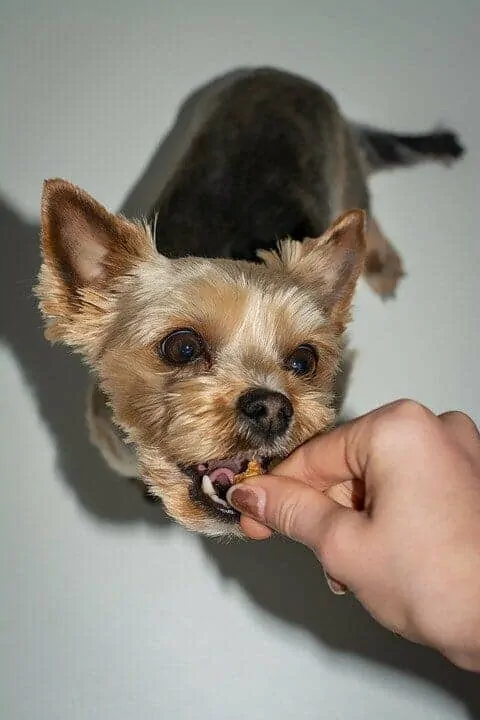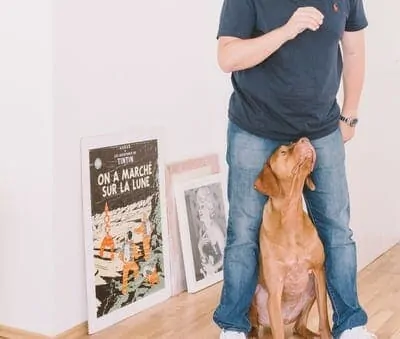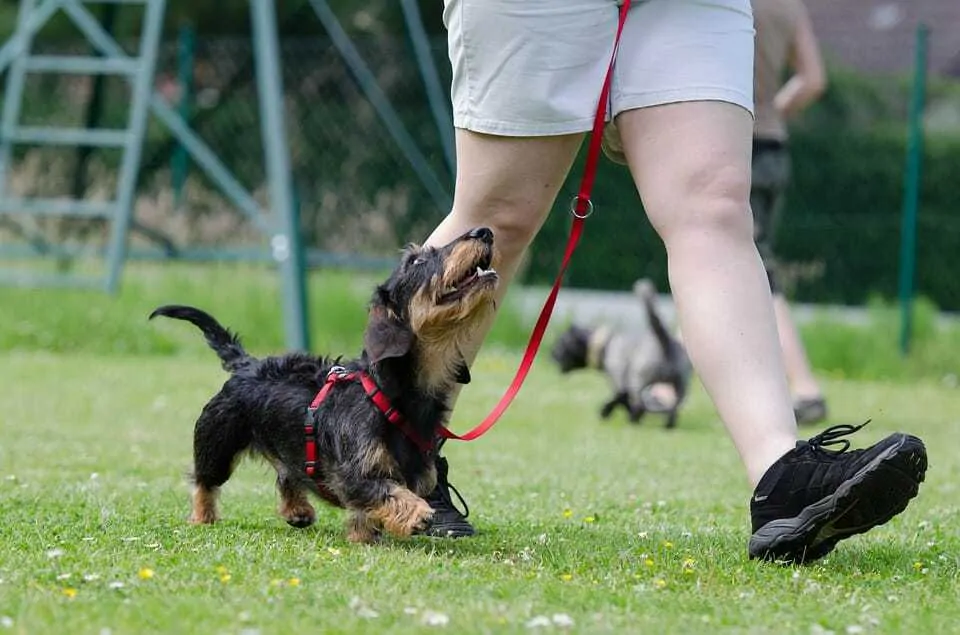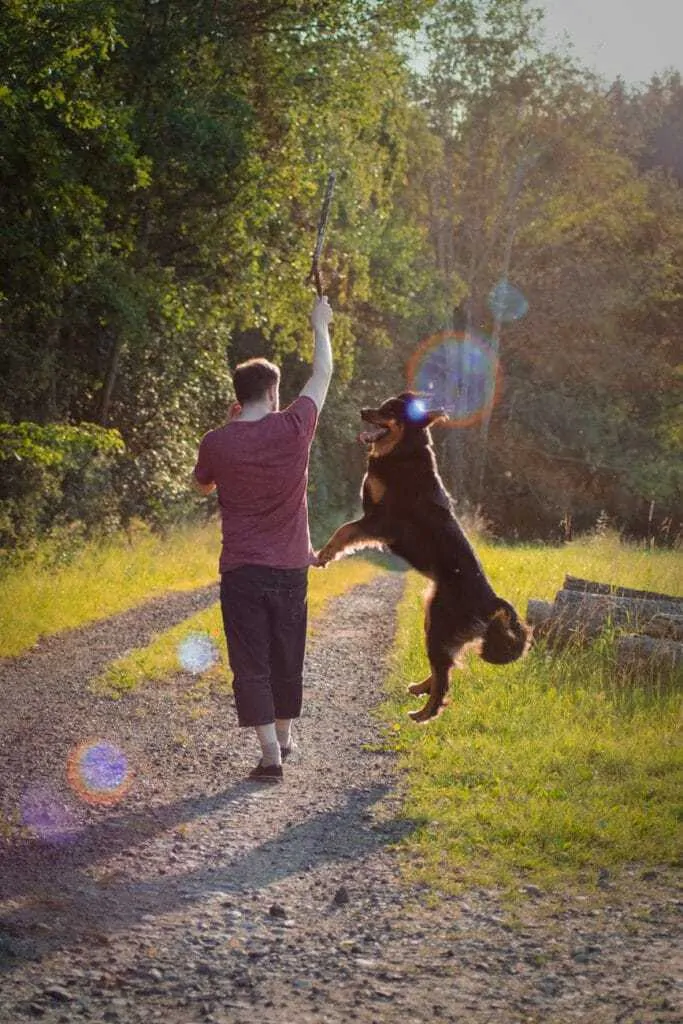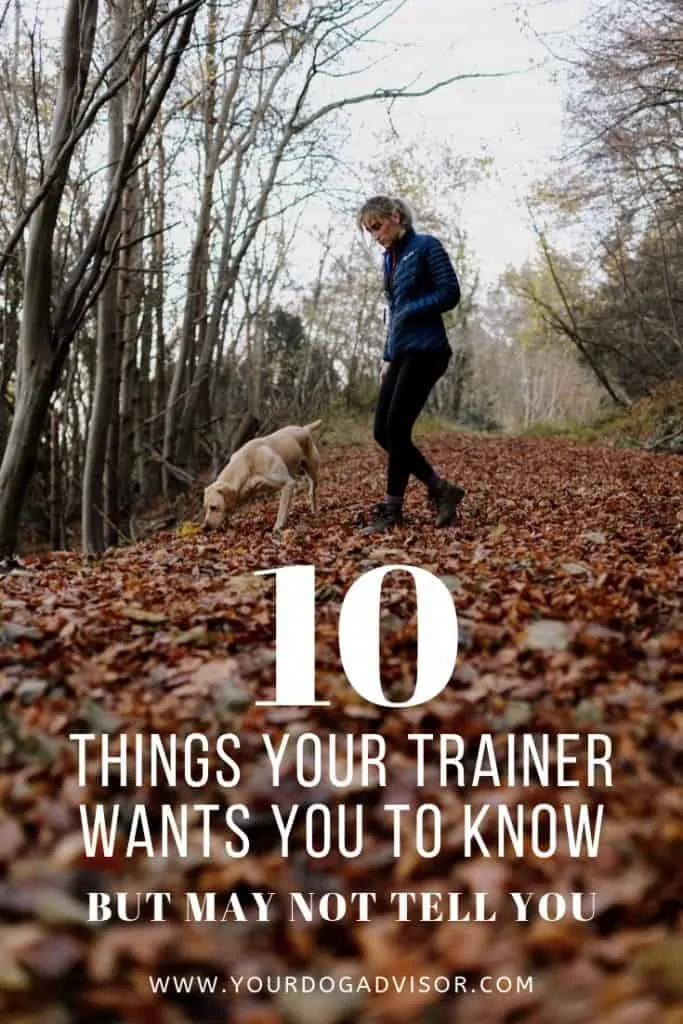Training and socializing your dog is an important part of being a responsible dog owner. Dog training not only helps your dog learn to be better behaved, but it is also a fundamental tool used to keep your dog safe and happy.
There are a number of training techniques experts use to help dogs become the best they can be, and there are endless words and phrases you yourself may have picked up or decided to use while training your dog.
But is there a right and a wrong way to train your dog? And what do the experts have to say about it?
Let’s find what your dog trainer wants you to know but may not tell you!
Contents
1. Your Trainer Isn’t Just Training Your Dog – They Are Also Training You
Perhaps one of the most difficult things about training a dog, according to most trainers I’ve spoken with, is that their owners sometimes expect a quick fix.
Many owners will hire a trainer in the hopes that the trainer will do all the work and bring their dog back “fixed” so they can go about their lives.
But the truth is, it doesn’t work that way.
Lily Reiche, Trainer and pet communications specialist with My Dog Spot, spoke with me briefly about what she wants her clients to take away from training sessions.
https://www.youtube.com/watch?v=RpT-0M9X-QY
In the video above, Lily explains that she’s not just training the dog; she’s also training the dog’s owner.
Dogs are intelligent and emotional creatures, and they are creatures of habit. So it doesn’t matter how much money you spend on a trainer and how well-behaved your dog acts in that trainer’s presence.
The real test is going to be when you and your dog are alone.
If you haven’t been paying attention to how your trainer is training your dog, then it will be easy for your dog to quickly pick back up on his bad habits once the trainer leaves, as there will be no one there to reinforce the good behavior he has just learned.
One of the biggest training mistakes we see dog owners make is that they don’t follow through with the consistency of the training.
That’s why, if you do plan on investing in a dog trainer for your dog, it is best for both you and Fido to pay attention to the trainer and learn together.
2. Most Trainers, Veterinarians, and Even Scientists Support Positive Reinforcement Methods When it Comes to Dog Training
Positive reinforcement methods have been proven to work and work well, according to research.
And most trainers, veterinarians, and even scientists have jumped on the bandwagon of positive reinforcement as opposed to punishment when it comes to training.
So, what does this mean for you and your dog?
Here’s the thing. It’s true that a few decades ago, rolling up a newspaper and swatting your dog on the nose for having a potty accident was all the rage. However, we now know so much more about our canine counterparts thanks to scientific studies and research programs.
We know that our dogs are intelligent, want to please us and work hard to be good.
This is why offering your dog treats and making a big deal about him sitting down on command is much more effective than scolding him for not sitting down when you told him to.
Remember, chances are your dog is not going to understand why you’re scolding him for not sitting. He will understand, however, that when he sat down he got a tasty treat and lots of praise.
And thus, the lightbulb will go off!
Positive reinforcement has consistently been proven to be the best and most effective method of training when it comes to dogs and the way they learn.
But positive reinforcement training methods go far beyond just your basic sit, stay, and heel commands.
Positive reinforcement can also be utilized when training your dog to walk on a leash, to come inside when called, and to play nicely with other dogs and people.
And while many well-meaning pet parents have invested in choke chains and shock collars in the past, we are starting to understand now more than ever that pet products that rely heavily on pain and fear to get a dog to behave are unnecessary.
In fact, they are much less effective than methods such as clicker training, praise, treats, front clip harnesses, and gentle leaders.
3. Training Your Dog Works Most Effectively When You Know How to Communicate With Your Dog
One of the most common complaints I hear from clients is that they don’t understand why their dog is doing the unfavorable thing their dog is doing.
Most experts agree that communication is key when training your dog to be the best he can be!
Whether a dog’s naughty behavior is digging in the garden, pulling on the leash, barking when the doorbell rings or chewing the legs of the dining room table, owners are often baffled by their dog’s seemingly random and unprovoked behavior.
What most trainers want dog owners to understand is that dogs rarely do things for no reason.
A digging dog is likely bored, while a chewing dog may be bored or anxious. Dogs who bark at the doorbell ringing may have doorbell anxiety, and so on.
When you first hire a trainer to help solve your dog’s problem behaviors, try and listen to what your trainer says about the reasons behind your dog’s actions.
Understanding your dog plays a key role in having a well behaved and happy pooch, and the better you know your canine and understand why he behaves the way he behaves, the quicker you will be able to help him learn how to be the best dog he can be.
4. Exercise, Diet, and A Healthy Lifestyle Play A Major Role In Your Dog’s Training Results
To some dog owners, this would seem like a no brainer, but you would be surprised how many times I’ve heard that a dog is “bad” or “ornery” only to later learn that the exact same dog eats a poor diet, gets little to no exercise, or stays cooped up in the backyard all day long by himself.
Dogs are social creatures who, like humans, need plenty of social interaction, a good, quality diet, and lots of exercise to stay not only healthy but happy as well.
And happy dogs are much better behaved dogs.
For dogs who have lots of energy, exercise is especially important in reducing unwanted and destructive behaviors like potty accidents, chewing, and barking.
And along with diet and exercise, your dog should also have plenty of mental stimulation to help keep him happy and healthy.
Just like people, dogs need a healthy diet, good, consistent activity, and a happy lifestyle to reach their full potential!
For busy dog owners, a trainer may advise you also invest in a quality dog walking service in your area or sending your dog to doggy daycare during the day to help him with his behavioral issues.
5. Intelligent Dogs Are Not Always Easier to Train
Many dog lovers take their time and research the type of dog they are getting long before they are getting said dog.
Other dog lovers go out on a whim and bring home a new dog with very little preparation.
And while we always agree that it’s better to be prepared, one of the most important things that your trainer wants you to know about being a dog owner is that the breed of your dog and his level of intelligence can play a role in how easy or difficult he is to train.
You may have thought that the smarter your dog is, the easier he will be to train! Well, think again!
For example, many herding breeds like Australian Shepherds are not only intelligent but also incredibly energetic and stubborn.
In fact, many brainy breeds are stubborn. That’s because the smarter the dog, the more independent the dog usually is.
And while most dogs are eager to please their humans and want to do right by them, smarter breeds will grow bored quickly of training sessions and may not find them as entertaining or mentally satisfying as some other breeds do.
This may lead to a training session that is short-lived, and that’s okay. Dogs may become bored with training after the first few minutes, and it’s fine to walk away, take a break, and come back later.
Trying to force your dog to sit through an unsatisfying training session will not get you the results you want any quicker and may even hinder the training process.
So, does that mean you should give up on trying to train your intelligent dog? Of course not. Intelligent dogs may often times need more consistent training than their other – um – we will just say less intelligent – counterparts.
Many of the world’s smartest dog breeds are working dogs, and working dogs need jobs to stay happy and healthy.
Training your dog the basics like sit, stay, heel, wait, bark, and roll over will only satisfy your brainy breed for so long.
Luckily, if you get the right trainer or do the right research, you should be able to harness your dog’s incredible genius and include him in the household chores.
I know plenty of smart dogs who bring in the newspaper, know how to load the dishwasher, carry in groceries, and even help with the laundry!
Along with proper training, your intelligent dog may also need more mental stimulation than most, and that’s where puzzle toys and other mentally stimulating dog products come in.
And for dog owners on a budget, you can learn how to make your own puzzle toys at home!
High energy dogs like Huskies can also be more difficult to train as they can become overstimulated easily and may also be easily distracted or stressed if they are not exercised enough.
This is yet another reason why exercise can help play such a large role in your dog’s success when it comes to training him.
6. You Can Totally Teach An Old Dog New Tricks!
It’s a funny little saying we’ve all heard – “You can’t teach an old dog new tricks”, but is there any truth to that quote?
Absolutely not.
As long as your dog has been well socialized and is eager to learn, he can continue to pick up new tricks until he is a senior!
So, whether you’ve had your dog since puppyhood or you are planning on adopting an adult dog, don’t be afraid of buying those training treats, hiring a trainer, or learning the proper way to train your dog yourself.
All dogs can continue to learn and train, no matter their age.
We should also note that there are plenty of training tips available that work brilliantly with dogs of any age.
And remember, while training does begin in puppyhood, it can and should be carried out throughout your dog’s life.
In fact, continuing to train and teach your dog new commands and tricks can actually be good for his mental and physical health, and may even help your dog live a better quality of life.
So, from teaching your dog his name to finding new ways of potty training him, to teaching him how to heel, shake, bark, and wait, don’t be afraid to grab some treats and start training your senior dog!
7. When Done Correctly, Training is A Wonderful Part of Bonding
We all know that building a bond with your dog starts from the moment you bring him home, but you can continue to strengthen that bond through proper training techniques.
Spending time with your dog and utilizing positive reinforcement methods during training is an excellent and proven way for your dog to learn to trust you.
And, when done right, training can feel like a game to your dog.
Most dogs enjoy training, and it helps them to bond with their owners.
Training your dog is also a good way to help your dog feel safe and protected by you.
Many of our four-legged friends’ behavioral issues stem from fear and anxiety. If you have an anxious dog, training is often vital to help counter condition them and help them feel safe and comfortable in their surroundings.
But even if your dog isn’t anxious, training is a fun and productive way to build on the wonderful relationship you already have with your dog, so do it!
8. Training Your Dog is an Ongoing Process
It happens more often than not. We will work wonders with a dog and the owners will be all impressed and pleased.
Then a few weeks later, the owners are calling us again, upset because our training didn’t stick.
But why is that?
Training is an ongoing process and can also be a wonderful part of bonding.
Training your dog doesn’t stop with the trainer. It is an ongoing process that requires you to pick up where your trainer left off.
This goes hand-in-hand with the idea that trainers are not just training your dog, but they are also training you on how to communicate with your dog, work with your dog, and encourage good behavior in your dog.
Furthermore, training takes time, and all dogs are different. My dog learned to sit in one day, but it took her a week to figure out how to lay down.
One of the dogs in my care took several days to figure out sit, but instantly picked up “shake” and “stay”.
Other types of training can take even longer. Properly crate training your dog, for example, can take weeks.
Dog owners who expect their dogs to learn overnight with a trainer and then don’t plan to continue with the training after the trainer leaves are, unfortunately, setting themselves and their dogs up for failure.
9. Your Dog Wants to Please You, So Be Patient
As I mentioned above, all dogs are different. Even dogs of the same breed have different personalities, fears, anxieties, and work ethic.
When training your dog, a good trainer will work to get to know your individual pooch, learn his signals and the way he communicates and will strive to help you understand how to best train him based on the way he learns and your lifestyle.
With that being said, it’s important to keep in mind that your dog really does want to please you.
In fact, studies have shown that dogs try hard to figure out what we are saying so that they can what we want them to do.
This is another reason why you should avoid punishing your dog during training sessions and use the positive reinforcement methods mentioned above.
No dog has a vendetta against you, knows how to hold a grudge, or wants to deliberately do something naughty to upset you.
So, if your dog isn’t catching on to his training sessions right away or he makes a few mistakes, be patient with him.
Studies have shown that dogs go out of their way to try and understand what we want of them.
And remember, while it is true that all dogs are different, there are some pretty common dog behavioral problems trainers see quite a bit.
Pay attention to your trainer and work to learn why your dog has the behavioral issues he has so that you can better understand him and in turn be a better trainer and pet parent.
10. Your Energy Is Contagious to Your Dog
Have you ever considered that some of your dog’s issues could be tied directly to you and your own behavior?
It’s kind of a hard pill to swallow, and we totally get it. But the truth is, your energy is entirely contagious to your dog.
Your dog may be pulling on his leash during walks for a number of reasons that are not his fault.
He may have the wrong type of leash or harness, or he may feel that he needs to protect you or be the leader and decision maker on the walk.
Your dog may be barking at the mailman as he passed by you on your walk because he felt your anxiety when you tightening your grip on his harness.
He may hide or urinate when the doorbell rings because the sound startles him and the excitement that ensues is overstimulating.
Our dogs work hard to understand us, and they are much more in tune with our feelings than you might realize.
If your dog exhibits behaviors that you don’t always understand, your trainer wants to remind you that your dog is much more in tune to you than you think.
If you are calm and relaxed, your dog is more likely to be calm and relaxed. If you are anxious, your dog is more likely to be anxious.
If you can, try and learn your dog’s signals and be aware of your surroundings. Know what sets him off, causes him anxiety, and work with him to make him feel safe and calm.
You can also work with your trainer to help your dog get through stressors and triggers, while also keeping in mind that your reaction, or lack thereof, can play a big part in why your dog behaves the way he does in certain situations.
So, do you have any questions or comments about how you can get the best out of your training session with your dog and trainer?
Drop me a line below.
And for more on how you can help your dog become the best version of himself, you can always do your own research, speak with your personal dog trainer, and order some dog training books.

Madison Guthrie (also known as Sonny Mackenzi) is a pet care specialist and positive-reinforcement trainer who works most closely with anxious and reactive dogs. Born and raised in Littleton, Colorado, Madison developed a love for animals at an early age and spent most of her childhood outdoors rescuing stray pets and helping to rehabilitate injured wildlife. Along with animals, Madison also developed a love for writing and music. Over the past five years, she has worked to use her passions to help the pets and pet parents in her community build stronger bonds and live happier, healthier lives together. Currently, Madison lives in South Pasadena, California where she owns and operates Miss Madison LLC, a marketing company that focuses on helping privately owned veterinary establishments and pet care companies grow and thrive. She also works as a dog trainer at My Dog Spot, which is an award-winning pet care and training establishment in Pasadena, California.
